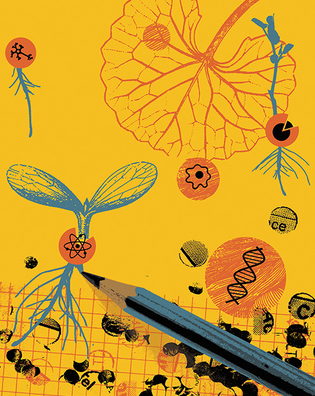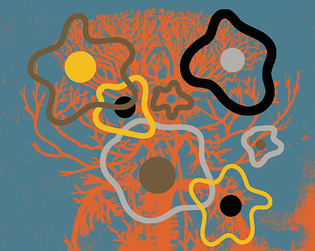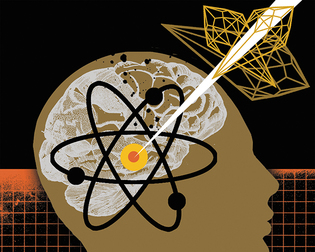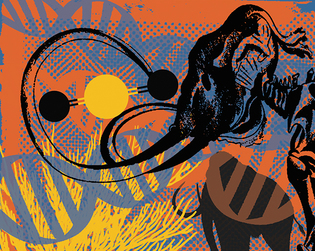 loading
loading
featuresBig ideasIf you could pick the best areas for science research at Yale, what would they be? Dylan Walsh ’11MEM is a freelance writer based in Chicago who covers science and criminal justice.  Shonagh RaeView full imageAt the Sheffield Scientific School of Yale University, in 1916—when annual tuition was $180—biology majors enrolled in Organs of Special Sense, civil engineering majors in Railway Curves and Earthwork, and physics majors in Sound and Light. Beyond their archaic lilt, these course titles are a measure of the great pace of scientific progress over the last century. Yale students today take Quantum Chemistry, Immunoengineering, and Astrostatistics and Data Mining. “Science is a constantly moving entity,” notes Scott Strobel, a professor in chemistry as well as molecular biophysics and biochemistry. “No committee I ran even a few years back would have predicted, say, the power of gene engineering from CRISPR.” As chair of the University Science Strategy Committee (USSC), Strobel had to exercise just these powers of prediction, trying to envision where science is going—and where it should be going—over the next several decades. President Peter Salovey ’86PhD and Provost Ben Polak convened the USSC in January 2017 to identify the most important currents in modern science. “What are the big ideas that we should be considering?” asks the charge letter. And how should Yale invest over the next ten years to become a research pioneer for each of those big ideas? What artifacts remain in Yale’s physical and administrative organization that might stifle the returns on investment? As far as Strobel knows, Yale had never undertaken such a sweeping consideration of its scientific endeavors. Big strategic plans traditionally involve some form of separate reports from every science department. While that process is more tractable, it also yields a disjointed and unfocused final product. The USSC forged instead into the realm of ideas, unconstrained by departmental boundaries, with deliberations traveling among the Schools of Medicine, Engineering, Arts and Sciences, Nursing, Public Health, and Forestry and Environmental Sciences. The process seemed to be novel elsewhere, too: searching for potential templates at other universities, he found nothing. (The most striking point of reference was a document published 12 years ago by the Stanford computer science department, which Strobel likened to a science fiction novel by H. G. Wells. “You look and say, ‘Oh my gosh, that’s what the world has become.’”) Academic assessments are also under way at Yale in the humanities and data-driven social sciences. But the effort of the USSC carried a particular, if implicit, urgency. “This was absolutely critical for us,” says Sten Vermund, dean of the School of Public Health. “When you think about optimized infrastructure for science, you think about MIT, Stanford, Harvard, Caltech. And Yale isn’t on that list.” No single cause accounts for Yale’s relative deficiency—“death of a thousand cuts,” according to Strobel—but the outcome presents a dangerous feedback loop: without the best people and the best equipment, Yale can’t compete for grants; without funding from grants, science at Yale slips further behind.
How do you distill the universe of science into a handful of investment priorities? Strobel began with a community-wide appeal. He asked every science department for a five-page writeup on the frontiers of their respective disciplines and how Yale could lead at those frontiers. Faculty from anywhere in the university were welcome to provide individual input. By April of 2017, the committee members—14 faculty and two associate vice presidents—had received 350 pages of ideas, each one deemed, by somebody, essential to the future of science. It was the job of the committee members to determine which ideas were most essential. They started reading. They composed long columns on whiteboards. They dropped ideas, they consolidated ideas, they tweaked ideas for greater specificity or ambition. They sought clarification. They knocked on the doors of faculty here and there and asked, “What are you thinking about these days? What are you working on?” By semester’s end, the group had whittled 350 pages down to 16 contenders, which they set aside temporarily. That summer, the committee turned its unsparing scrutiny to the organizational and structural blueprint of Yale. How, it debated, could the university be rearranged to improve support not only for the few ideas ultimately selected, but for all of science? Starting in the fall of 2017, the committee organized 16 two-hour discussions—one for each of the finalist topics—with faculty experts in the field. After these concluded in February, the committee convened for a series of closed-door meetings, in which it overlaid resource constraints on each proposal. “It was like using Monopoly money,” says Strobel. “If we had an imaginary 100 million dollars, what would we spend it on? We used that as a criterion to help us decide what to do.” The members took part in a series of votes at the end of April, slowly narrowing the options, one by one striking possibilities from the running. Strobel politely declined to comment about the details of this process—where negotiations may have stalled or grown heated—but it’s not difficult to imagine how much political finesse it must have taken to generate consensus on five ideas, down from hundreds, for “top priority investment.” The USSC delivered those five ideas in June of this year, 18 months after its first meeting. Attached to each idea is a recommendation for creating or expanding a multidisciplinary institute. While there is variability in what the institutes might ultimately look like, their unifying factor is the need for fertile collaboration across boundaries, for physical spaces where the work of scientists in different fields can collide and mesh. As of this writing, the report had been published and faculty, alumni, and administrators were starting to send feedback. If the committee members prove sufficiently prescient, their fingerprint will be visible in the 2050 course catalogues—and not just at Yale. What follows is a short guide to the five “big ideas” the committee recommended. Neuroscience, from molecules to mindSomewhere in the coiled masses of our brains sit memories and emotions and thoughts—the core of what seems to differentiate us as individuals and as a species. Understanding the human brain, with its 100 billion neurons and 80 trillion synaptic connections, is a challenge of both grand magnitude and urgency. As many as 100 million Americans are afflicted by neurological disease, with the economic burden from these diseases estimated to be over $800 billion. The USSC proposal for a neuroscience institute aims to understand both the developmental process of a normal brain and the deviations that lead to neurological pathologies. Tackling these questions requires concerted effort across a range of disciplines, which would all be housed under a single roof. Understanding autism, for example, will require input from scientists in molecular genetics, cellular biology, developmental biology, physiology, and cognition. The institute would also work on a question rarely pursued in neuroscience research: what accounts for uniqueness in brains across species? Finally, cooperation between departments would help “to guide recruitment of new faculty and to drive new research avenues,” according to Christopher Burd, the deputy chair of Yale’s Department of Cell Biology, who was not on the committee.  Shonagh RaeView full imageInflammation scienceThe standard picture of inflammation is familiar: after an acute injury or illness, white blood cells launch a counterattack, causing swelling, redness, and fever, and the harm is eventually eliminated. The cut heals, the illness subsides. While this description is accurate, a more complicated picture of inflammation has emerged in recent years. “There is more chronic and low-grade inflammation—that occurs in response to, say, a high-fat diet or diabetes,” says Akiko Iwasaki, a professor of immunobiology and of molecular, cellular, and developmental biology who was a member of the committee. This insight has led to the understanding that inflammation is not simply an acute response to harm; rather, each organ system can operate in either a normal or an inflammatory mode, with this inflammatory mode likely implicated in much chronic disease. “Inflammation, as broadly defined, is an important component of nearly every class of human disease,” says Jeffrey Bender, director of Yale’s cardiovascular research center and professor of medicine and immunobiology. (Bender was not on the committee.) Establishing an institute for inflammation, as the report suggests, “is likely to have a major impact on both fundamental and disease-based discovery research at Yale, including in highly prevalent conditions such as diabetes, cardiovascular disease, and cancer.” A central motivation behind the institute is bringing distant fields of expertise into a single building, with immunologists working alongside physiologists, biochemists, and microbe researchers. “We don’t have that setup at Yale now,” says Iwasaki; but putting it in place would support the study of inflammation across scales and systems within the body, opening lines of inquiry that are currently inaccessible—the link between inflammation and the nervous system, for instance, which is of particular interest to Iwasaki. “There are a lot of neurological diseases that are probably caused by inflammation,” she says. “If we can stop inflammation by interfering with the connection between these systems then we may provide a mode of therapy not considered before.” Data science and its mathematical foundationsA common problem unites almost every academic discipline today: too much data. It’s not always of the highest quality, it’s not always the right type or format, but we now collect data far faster than we can organize or analyze it. The USSC proposed tackling this challenge with an institute that links research in data science and mathematics. On the data science side, the institute would study refinements in the acquisition and interpretation of data, as well as methods for making the algorithms that are used to analyze data more effective and transparent. On the mathematics side, researchers would push to understand key problems in math where the absence of solutions hinders the advancement of data science. Taken together, this work could spur better analysis in a range of research fields, from precision medicine to climate change to criminal law. The institute would also try to build ethical fences around its work. “On the technical side, data scientists tend to be pretty good at thinking about what we can do, but we also need to think about what we want to do, what’s right to do,” says Daniel Spielman ’92, a professor of computer science and mathematics and a committee member. To this end, he says, the institute would incorporate the perspectives of professors in political science, philosophy, and law. This idea addresses two needs at once: first, the institute could help meet the growing demands for help from faculty across the university who are struggling under expanding volumes of data. In astronomy, for example, the old model in which individual astronomers visit telescopes and collect their own data “is on its way out,” says Sarbani Basu, chair of the Yale astronomy department, who did not sit on the committee. More common today are groups of researchers collaborating on large-scale surveys of space; this work produces “more data than the average astronomer is used to handling and we need to train our students and postdocs” how to find what they need. The institute, she hopes, would provide this support, serving as a hub for anybody with questions. Second, the institute would advance the field of data science at large, not least because of its work with professors from around Yale. Work on challenges from the real world, Spielman notes, has been responsible for most major leaps forward in data science. “Having regular access to people with interesting and important problems will improve our research,” he says. “If someone comes to me with a problem and I can solve it, they’re very happy. If they come to me with a problem and I can’t solve it, then I’m happy. It means I have something to work on.”  Shonagh RaeView full imageQuantum science, engineering, and materialsThe first quantum revolution took place roughly between 1900 and 1927, when the era’s top physicists—Niels Bohr, Max Born, Werner Heisenberg, among others—formulated the theory’s mathematical foundation. “The theory is so counterintuitive and bizarre that we failed to recognize some of its implications, about how weird features of quantum mechanics could be used for tasks in computing, communicating, and enhancing privacy,” says Steven Girvin, a professor of theoretical physics and committee member. The second quantum revolution is now under way, he says, thanks to “that realization gradually dawning on us over the last 25 years.” Quantum computers are the most recognizable face of this revolution—an embryonic technology that Girvin says is “the highest-risk and perhaps highest-reward aspect” of the field. But there is a remarkable breadth of application for quantum ideas. In the life sciences, for instance, scientists currently have the capability to insert a single nitrogen atom into a microscopic sliver of diamond and, with a laser targeting the nitrogen, use the quantum principles of this unlikely machine in order to detect when neurons are firing in the brain or to measure the temperature inside a cell. Given the promise of emerging quantum technologies, the USSC recommended the establishment of a university-wide quantum initiative that would enlarge the existing Yale Quantum Institute. The initiative would focus on three areas: computing, communication, and data security; sensors and measurement techniques; and materials.  Shonagh RaeView full imageEnvironmental and evolutionary sciencesSince the middle of last century, ecologists have been forced to rely on rough abstractions of the world around them. “For a long time we were stuck in this place where we knew the systems we were studying were far more complex than our models, but we didn’t know how to get around that,” says David Skelly, a committee member and professor at the School of Forestry and Environmental Studies. It felt, he says, like looking at the moon through a crude telescope. But new techniques to analyze and understand genetics have provided ecologists and evolutionary biologists “a much clearer vision into how evolution and ecology work together.” The USSC proposed an institute to investigate links between environmental and evolutionary changes, as well as the roles of humans in both realms. Technological advances point to the possibility of large-scale ecological and evolutionary interventions, and Skelly notes that the consideration and discussion of complex ethical questions is becoming unavoidable. How should we think about de-extinction efforts that aim to resurrect mammoths and passenger pigeons? What about manipulating soil microbes to store more carbon, or creating coral that is resistant to acidic oceans? Interventions of this sort will almost certainly be carried out in years to come, says Skelly. “We need to have good research on the front end or we could end up in a bad place.” Alongside these five recommendations, the committee listed five secondary science priorities where Yale is already making valuable headway. These include climate solutions, computer science, conquering cancer, precision medicine, and regenerative medicine. An appendix to the report also listed eight “scientific areas that captured our imaginations.” Taken together, “the areas identified in the USSC report can be considered ‘centers of gravity’ that all of Yale’s science departments, and even some departments outside of scientific disciplines, orbit at some altitude,” says Christopher Burd. “The initiative emerged from the recognition that our institutional priorities need to be assessed and recalibrated every generation or so in order to maintain Yale’s leadership in research and education.” And yet, even with 18 proposed research subjects, “you worry about winners,” Strobel says. “Because if there are winners, then there must be losers.” No one interviewed expressed strong regrets—though Vermund did touch briefly on the fact that the vast subject of global health has been relegated to the appendix, with only a single paragraph of advocacy. And Basu felt that an undertaking like the data science institute must “have a strong pedagogical component—otherwise it will not help us much.” (She is optimistic that this will be the case.) To get ahead of these concerns—no matter what, it can’t feel good if suggestions for your specialty are not selected—the committee suggested four investments unattached to specific fields of science. These included three years of guaranteed financial support for graduate students, diversifying the STEM pipeline from elementary school through university, support for the development of new scientific instruments, and investments in core facilities, which provide faculty access to high-demand technologies like clean rooms or genome sequencers. Of course, Yale faces real resource constraints, not pools of Monopoly money. It costs money to build buildings and hire faculty and provide tools for inventing new scientific instruments. It costs money to recruit more graduate students and pay their way and to buy advanced machinery for core facilities. With this in mind, the committee also provided ten nearly costless ways for Yale to improve the research process by reconsidering antiquated rules and the distribution of resources across the university. When trying to fill interdisciplinary appointments, for instance, departments often run up against trivial but insurmountable challenges, like mismatched tenure clocks: one school may give assistant professors six years to make tenure, another school seven years. “These different structures between departments make it difficult if not impossible to pull off” joint hires, Strobel explains. The committee encouraged examining these small administrative impediments and relaxing historical definitions of what it means to be a faculty member. Two other recommendations describe the need for Yale to better support applications for large grants and for entrepreneurship and commercialization among science faculty. Strobel also called out the value of partnering with Brookhaven National Laboratory, only 30 miles away. This kind of partnership could open access to sophisticated research tools and build novel collaborations. The USSC findings mark the end of one process and the beginning of another. The spotlight has now shifted to the provost’s and president’s offices, which will work through the details of implementation. To begin, the provost has turned the committee’s report over to Yale’s Board of Trustees and faculty—whose ideas were the seeds from which this work grew—for their comment. The report is available also on Yale’s website for alumni to read and comment on. These rounds of feedback will likely shift conclusions the USSC spent 18 months nailing into place. One FES professor, Oswald Schmitz, has already commented that the environmental section “doesn’t identify big-picture grand challenges.” Strobel disagrees; the report, he notes, highlights climate change and ways to curb its effects. But dissent and disagreement are essential as the debate moves forward. “We view this as a living document,” he says. “Just as science is a living process.”
|
|
2 comments
-

Bobbin Zalsh, 12:47pm September 17 2018 |  Flag as inappropriate
Flag as inappropriate
-

Beerface Handswing, 6:09am October 14 2018 |  Flag as inappropriate
Flag as inappropriate
The comment period has expired.An expertly crafted article. This staff writer is here to stay!
How about the effects of beer on the brains of Yale alums?